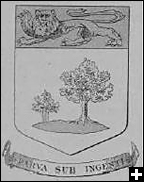Common menu bar links
Local Government of Canada, 1915 — Prince Edward Island
Archived Content
Information identified as archived is provided for reference, research or recordkeeping purposes. It is not subject to the Government of Canada Web Standards and has not been altered or updated since it was archived. Please contact us to request a format other than those available.
Prince Edward Island
At the time of entering the union the government of Prince Edward Island consisted of a Governor and an Executive Council, a Legislative Council of 13 members and a House of Assembly of 30 members. The Legislative Council was made elective in 1862 and so continued until its abolition after the union in 1873. The former Legislative Council districts, after the passage of the Abolition Act, elected members to the Legislative Assembly, fifteen in number, while the same districts elected members to the Assembly on a different franchise, thus practically amalgamating the two Houses into one Assembly of 30 members. The electoral system, as far as voting is concerned, is practically one of manhood suffrage. The Executive Council of Prince Edward Island consists of (1) the President of the Council, (2) the Provincial Secretary-Treasurer, who is also Commissioner of Agriculture, (3) the Commissioner of Public Works and seven members without portfolio.
 With regard to the judiciary, the Supreme Court has a chief justice and two assistant judges. The chief justice is also the local judge in admiralty of the exchequer court. The supreme court is also a court of appeal and has jurisdiction in appeal chancery cases. It has original jurisdiction both in civil and criminal matters. In civil cases of debt the action must be for an amount above $32, and all cases beyond the jurisdiction of the county court may be tried before a judge of the supreme court. The assistant judges of this court have also chancery powers. There is a surrogate and probate court for the province with one judge. A system of county courts is established consisting of three judges, one for each county. These are appointed and paid by the federal government and have jurisdiction in suits up to the sum of one hundred and fifty dollars. Education is under the direction of a Board of Education consisting of the members of the Executive Council of the province and the Superintendent of Education, who is also secretary of the Board. Agricultural education is assisted from the grants made by the federal government of which the yearly amount is over $27,000. The Agricultural Department works in this matter in conjunction with the Department of Education with the happiest results.
With regard to the judiciary, the Supreme Court has a chief justice and two assistant judges. The chief justice is also the local judge in admiralty of the exchequer court. The supreme court is also a court of appeal and has jurisdiction in appeal chancery cases. It has original jurisdiction both in civil and criminal matters. In civil cases of debt the action must be for an amount above $32, and all cases beyond the jurisdiction of the county court may be tried before a judge of the supreme court. The assistant judges of this court have also chancery powers. There is a surrogate and probate court for the province with one judge. A system of county courts is established consisting of three judges, one for each county. These are appointed and paid by the federal government and have jurisdiction in suits up to the sum of one hundred and fifty dollars. Education is under the direction of a Board of Education consisting of the members of the Executive Council of the province and the Superintendent of Education, who is also secretary of the Board. Agricultural education is assisted from the grants made by the federal government of which the yearly amount is over $27,000. The Agricultural Department works in this matter in conjunction with the Department of Education with the happiest results.
A distinguishing feature of enterprise in Prince Edward Island is the breeding of fur-bearing animals for which the climate, soil and general surroundings seem peculiarly well adapted. The industry has proved very profitable, and the Commissioner of Agriculture in his latest report expresses satisfaction with the progress so far made.
In 1915 the ordinary revenue amounted to $470,730 and the expenditure to $510,345.
